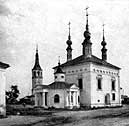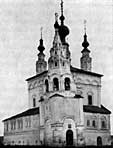| Виртуальный Владимир » Город Владимир » Old Russian Towns » Suzdal » Historic buildings » Church oi the Emperor Constantino |
 ...
... On the way to the Cathedral of the Nativity
On the way to the Cathedral of the Nativity Cathedral of the Nativity
Cathedral of the Nativity Archbishops palace and bell-tower
Archbishops palace and bell-tower Church of St. Nicholas
Church of St. Nicholas Church oi St. Boris and St. Gleb
Church oi St. Boris and St. Gleb Monastery of St. Dmitri
Monastery of St. Dmitri Church of St. Nicholas
Church of St. Nicholas Church of St. Cosmas and St. Damian
Church of St. Cosmas and St. Damian Church of the Sign
Church of the Sign market place
market place Church of John the Baptist
Church of John the Baptist Church of the Entry into Jerusalem
Church of the Entry into Jerusalem Gostiny Dvor
Gostiny Dvor Church of the Resurrection
Church of the Resurrection Church oi the Emperor Constantino
Church oi the Emperor Constantino Church of St. Lazarus
Church of St. Lazarus Convent of the Deposition of the Robe
Convent of the Deposition of the Robe Holy Gates
Holy Gates Cathedral of the Deposition of the Robe
Cathedral of the Deposition of the Robe Trinity Cathedral
Trinity Cathedral Monastery of St. Alexander
Monastery of St. Alexander brick kiln
brick kiln Church of Tanners Settlement
Church of Tanners Settlement Church of Our Lady of Tikhvin
Church of Our Lady of Tikhvin Church of St. Peter and St. Paul
Church of St. Peter and St. Paul Convent ot the Intercession
Convent ot the Intercession Church of the Conception
Church of the Conception Spaso-Yevfimiev Monastery
Spaso-Yevfimiev Monastery Cathedral oi the Transfiguration
Cathedral oi the Transfiguration Church of Our Lady of Smolensk
Church of Our Lady of Smolensk 17th century house
17th century house Monastery of St. Basil
Monastery of St. Basil Yuri Dolgorukys castle
Yuri Dolgorukys castle Church oi St. Boris and St. Gleb
Church oi St. Boris and St. Gleb In the northeast corner of the square there is the ensemble of the Church oi the Emperor Constantino. Like so many other stone churches in Suzdal it stands on the site of an earlier wooden group of buildings by the northeast gates of the stockade. The main church, with its south wall facing the square, was built in 1707 at the same time as the Church of the Entry into Jerusalem but is incomparably more monumental and sumptuous than the latter. Its white walls are decorated with a wide cornice of small, deeply recessed, horseshoe-shaped kokoshniks and ornamental bands similar tc those on the Church of the Resurrection bell-tower, which look like a strip of embroidery. The tops of the windov surrounds are elaborately moulded. In sharp contrast tc the elegant simplicity of the walls, the roof is crownec with five extremely intricate domes on slender drums decorated with a band of small columns in high relief, on which the architect seems to have concentrated his flair for ornamentation. The splendid roof, the dramatic interplay between simplicity and elaborate detail, and the overall decoration of the church are all very reminiscent of the former Trinity Cathedral in the Convent of the Deposition of the Robe.
In the northeast corner of the square there is the ensemble of the Church oi the Emperor Constantino. Like so many other stone churches in Suzdal it stands on the site of an earlier wooden group of buildings by the northeast gates of the stockade. The main church, with its south wall facing the square, was built in 1707 at the same time as the Church of the Entry into Jerusalem but is incomparably more monumental and sumptuous than the latter. Its white walls are decorated with a wide cornice of small, deeply recessed, horseshoe-shaped kokoshniks and ornamental bands similar tc those on the Church of the Resurrection bell-tower, which look like a strip of embroidery. The tops of the windov surrounds are elaborately moulded. In sharp contrast tc the elegant simplicity of the walls, the roof is crownec with five extremely intricate domes on slender drums decorated with a band of small columns in high relief, on which the architect seems to have concentrated his flair for ornamentation. The splendid roof, the dramatic interplay between simplicity and elaborate detail, and the overall decoration of the church are all very reminiscent of the former Trinity Cathedral in the Convent of the Deposition of the Robe.
 It is possible that the Church of the Emperor Constantine was also the work of Mamin, Gryaznov and Shmakov or their apprentices. Its elaborate roof strikes a very festive note and emphasises the importance of the building in the ensemble on the square. The circular classical narthex with its double-columned porticos, built on to the west wall at the beginning of the nineteenth century, blends in well with the older building of the church itself and balances the sanctuary which was rebuilt at the end of the eighteenth century.
It is possible that the Church of the Emperor Constantine was also the work of Mamin, Gryaznov and Shmakov or their apprentices. Its elaborate roof strikes a very festive note and emphasises the importance of the building in the ensemble on the square. The circular classical narthex with its double-columned porticos, built on to the west wall at the beginning of the nineteenth century, blends in well with the older building of the church itself and balances the sanctuary which was rebuilt at the end of the eighteenth century.
Northeast of the main church stands the small heated Church of Our Lady of the Sorrows (1787) connected to a tent-shaped bell-tower. The latter contains several features borrowed from the bell-tower of the Church of St. Nicholas, but the lower section of the octagon is simpler making the tower fit in with the architecture of the main church. Its elaborate tent-shaped spire with tiny octagonal windows and needle-like dome blends in well with the domes of the main church. The designer was particularly fond of the motif of glazed red and green baluster-shaped tiling which he used on the top of the spire as well as the octagon of the bell-tower and the cornice on the church itself. This brightly coloured majolica ornament looked like strings of shining red and green beads encircling the church and bell-tower. The building was restored in 1952.
Оставить комментарий:



 Виртуальный Владимир
Виртуальный Владимир Область
Область Панорамы города
Панорамы города Организации
Организации Улицы и дома
Улицы и дома Добавить организацию
Добавить организацию О городе
О городе










